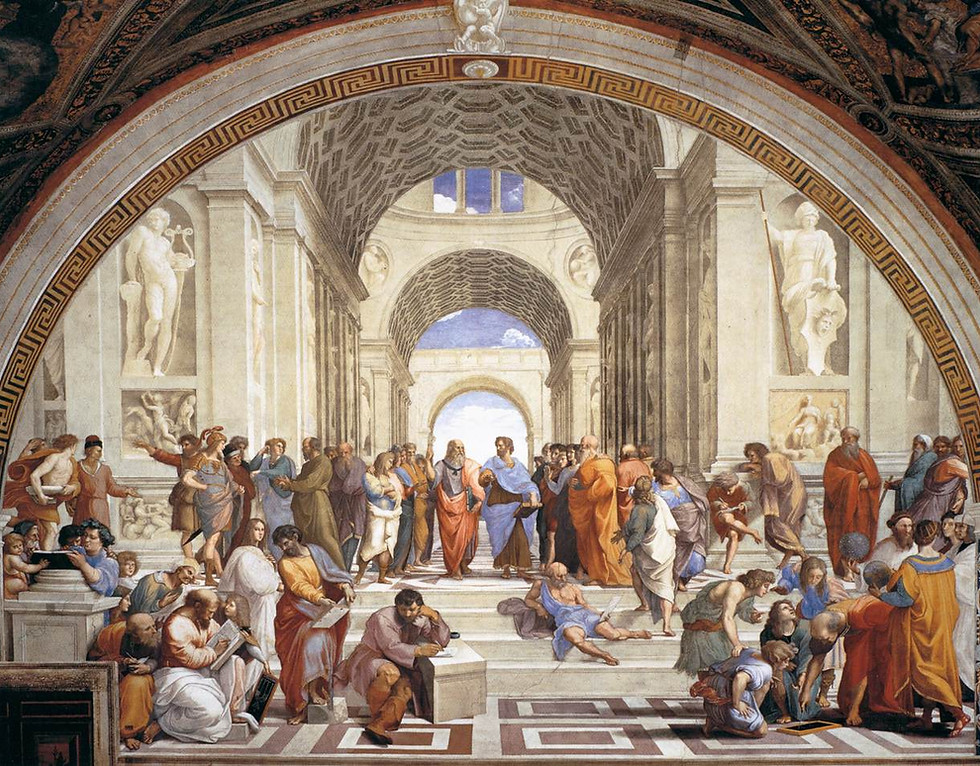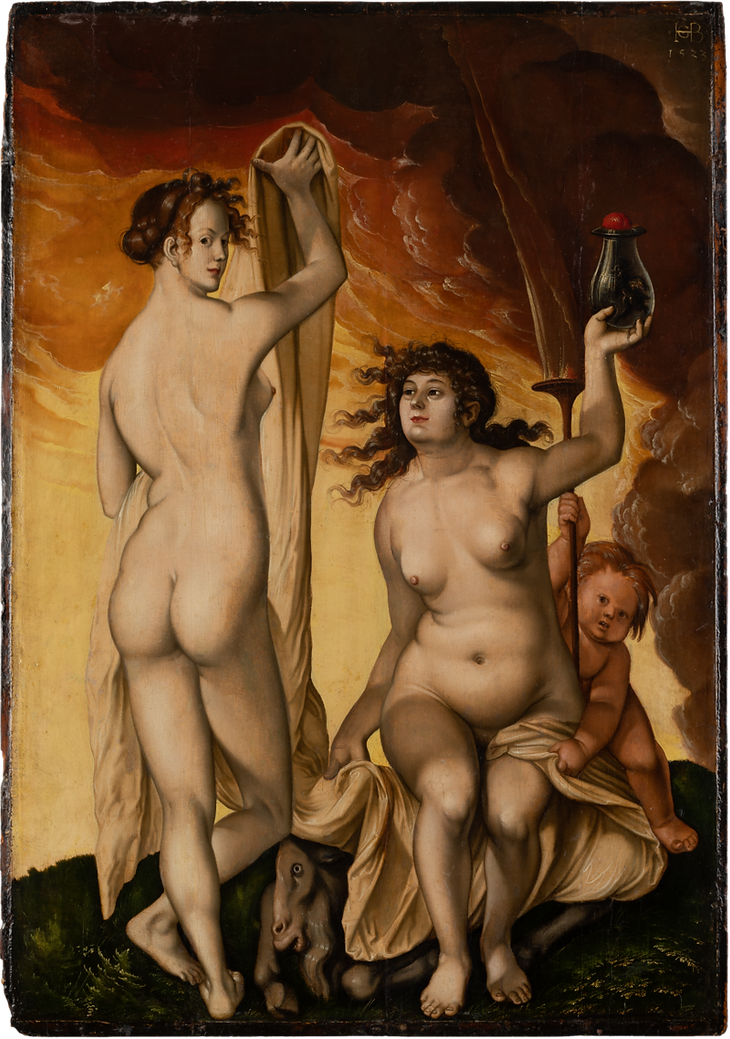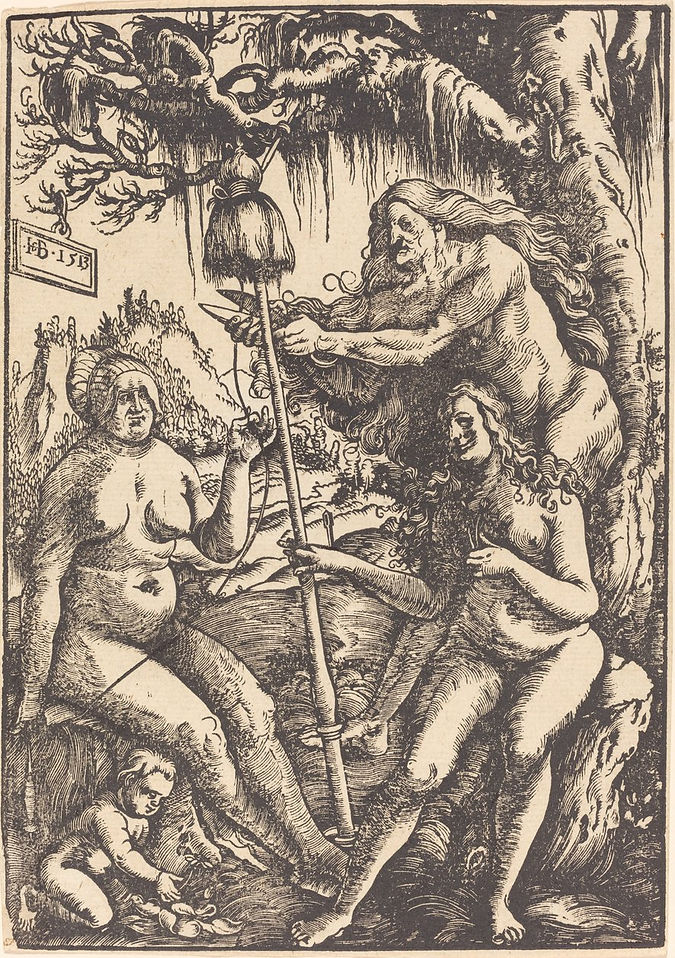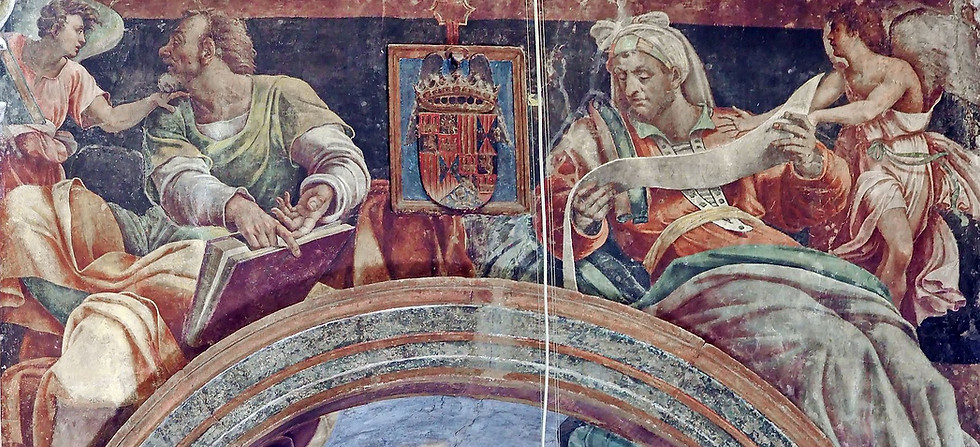
Renaissance - VI
Raphael
1483 – 1520
Raffaello Sanzio da Urbino (March 28 or April 6, 1483 – April 6, 1520), now generally known in English as Raphael, was an Italian painter and architect of the High Renaissance. His work is admired for its clarity of form, ease of composition, and visual achievement of the Neoplatonic ideal of human grandeur. Together with Leonardo da Vinci and Michelangelo, he forms the traditional trinity of great masters of that period.
His father was court painter to the ruler of the small but highly cultured city of Urbino. He died when Raphael was eleven, and Raphael seems to have played a role in managing the family workshop from this point. He trained in the workshop of Perugino, and was described as a fully trained "master" by 1500. He worked in or for several cities in north Italy until in 1508 he moved to Rome at the invitation of Pope Julius II, to work on the Apostolic Palace at the Vatican. He was given a series of important commissions there and elsewhere in the city, and began to work as an architect. He was still at the height of his powers at his death in 1520.
Raphael was enormously productive, running an unusually large workshop and, despite his early death at 37, leaving a large body of work. His career falls naturally into three phases and three styles, first described by Giorgio Vasari: his early years in Umbria, then a period of about four years (1504–1508) absorbing the artistic traditions of Florence, followed by his last hectic and triumphant twelve years in Rome, working for two popes and their close associates.[7] Many of his works are found in the Vatican Palace, where the frescoed Raphael Rooms were the central, and the largest, work of his career. The best known work is The School of Athens in the Vatican Stanza della Segnatura. After his early years in Rome, much of his work was executed by his workshop from his drawings, with considerable loss of quality. He was extremely influential in his lifetime, though outside Rome his work was mostly known from his collaborative printmaking.

Self-portrait of Raphael, aged approximately 23

Elisabetta Gonzaga
c. 1503

Diotalevi Madonna
c. 1503

Sposalizio (The Engagement of Virgin Mary)
1504

The Three Graces
1504-05

Allegory (The Knight's Dream)
c. 1504

Madonna with the Book (Conestabile Madonna)
1504

Madonna and Child (The Small Cowper Madonna)
1504-05

St George and the Dragon
1505-06

St Michael and the Dragon
1503-05

Terranuova Madonna
c. 1505

Lady with a Unicorn
c. 1505

Lady with a Unicorn
c. 1505

Portrait of Maddalena Doni
1506

Madonna of Belvedere (Madonna del Prato)
1506

Madonna del Cardellino
1507

Bridgewater Madonna
c. 1507

The Canigiani Madonna
1507

Portrait of a Woman (La Muta)
1507

Madonna del Baldacchino
1507-08

The Holy Family with a Lamb
1507

Madonna and Child (The Tempi Madonna)
1508

Madonna with Beardless St Joseph
1506

The Entombment
1507

Stanza della Segnatura: The School of Athens
1510-1511

Stanza della Segnatura: The School of Athens
An elder Plato walks alongside a younger Aristotle.

Stanza della Segnatura: La Disputa
1510-1511

Stanza della Segnatura: The Parnassus
1510-1511

The Fire in the Borgo
1514

Justice
c. 1520

Madonna with the Blue Diadem
1510-11

The Voyage of Galatea
1511

The Alba Madonna
1511

The Sistine Madonna
1513-14

The Sibyls
c. 1514

Madonna della Seggiola (Sedia)
1514

Portrait of Baldassare Castiglione
1514-15

Portrait of a Young Woman (La Fornarina, Raphael's mistress)
1518-19

Stanza della Segnatura: The School of Athens

The Transfiguration (detail)
1518-20
Hans Baldung
1484 / 1485 – 1545
Hans Baldung (1484 or 1485 – September 1545), called Hans Baldung Grien,[a] (being an early nickname, because of his predilection for the colour green), was a painter, printer, engraver, draftsman, and stained glass artist, who was considered the most gifted student of Albrecht Dürer and whose art belongs to both German Renaissance and Mannerism.
Throughout his lifetime, he developed a distinctive style, full of colour, expression and imagination. His talents were varied, and he produced a great and extensive variety of work including portraits, woodcuts, drawings, tapestries, altarpieces, and stained glass, often relying on allegories and mythological motifs.

Self-portrait, 1516 (detail from the High altar of Freiburg Minster)
Hans Baldung

Knight, Death and girl
c.1505

Adoration Of The Magi
1507

St Sebastian Altarpiece
1507

Knight, Death and girl
c.1505

New Year's Greeting with Three Witches: DER COR CAPEN EIN GVT JAR
(1514)

Two Witches
1523

Death and the Maiden, 1510

Death and the Maiden,
1517

Death and the Maiden, 1518-20

Eve, the Serpent, and Death
1510-12

The Mass of St Gregory
1511

Phyllis and Aristotle
1515
The tale of Phyllis and Aristotle is a medieval cautionary tale about the triumph of a seductive woman, Phyllis, over the greatest male intellect, the ancient Greek philosopher Aristotle. It is one of several Power of Women stories from that time. Among early versions is the French Lai d'Aristote from 1220.
The story of the dominatrix and the famous intellectual was taken up by artists from the 12th century onwards, in media from stone sculpture in churches to panels of wood or ivory, textiles such as carpets and tapestries, engravings, oil paintings, brass jugs (aquamanile), and stained glass.

Adam and Eve

The Seven Ages of Woman

Prudence
1529

Music
1529

Three Ages of Man and Three Graces
1539

Death and youth

Battle of the Knights with the death
(Schlacht der Ritter mit dem Tod)

The Walk to Death
(Der Weg zum Tod)

Witch

The Three Fates: Lachesis, Atropos and Clotho

The Witches' Sabbath

Allegorical representation

The Flood, 1516
Sebastiano del Piombo
c. 1485 – 1547
Sebastiano del Piombo (c. 1485 – 21 June 1547) was an Italian painter of the High Renaissance and early Mannerist periods famous as the only major artist of the period to combine the colouring of the Venetian school in which he was trained with the monumental forms of the Roman school. He belongs both to the painting school of his native city, Venice, where he made significant contributions before he left for Rome in 1511, and that of Rome, where he stayed for the rest of his life, and whose style he thoroughly adopted.
Born Sebastiano Luciani, after coming to Rome he became known as Sebastiano Veneziano or Viniziano ("Sebastian the Venetian"), until in 1531 he became the Keeper of the Seal to the Papacy, and so got the nickname del Piombo ("of the Lead") thereafter, from his new job title of piombatore. Friends like Michelangelo and Ariosto called him Fra Bastiano ("Brother Bastian").
Never a very disciplined or productive painter, his artistic productivity fell still further after becoming piombatore, which committed him to attend on the pope most days, to travel with him and to take holy orders as a friar, despite having a wife and two children. He now painted mostly portraits, and relatively few works of his survive compared to his great contemporaries in Rome. This limited his involvement with the Mannerist style of his later years.
Having achieved success as a lutenist in Venice when young, he turned to painting and trained with Giovanni Bellini and Giorgione. When he first went to Rome he worked alongside Raphael and then became one of the few painters to get on well with Michelangelo, who tried to promote his career by encouraging him to compete for commissions against Raphael. He painted portraits and religious subjects in oils, and once he was established avoided the large fresco schemes that took up so much of the time of Raphael and Michelangelo. His earlier career in both Venice and Rome was somewhat overshadowed by the presence of clearly greater painters in the same city, but after the death of Raphael in 1520 he became Rome's leading painter. His influence on other artists was limited by his lack of prominent pupils, and relatively little dissemination of his works in print copies.

Sebastiano del Piombo, The Violinist, sometimes claimed to be a self-portrait

The Judgment of Solomon,
1508–1510

The Daughter of Herodias
1510

Adoration of the Shepherds,
1511–12

Death of Adonis
c. 1512–13

Ferry Carondelet with his Secretaries,
1512

The Viterbo Pietà,
c. 1515

Descent into Limbo,
1516,
left wing of a triptych.

The Flagellation in San Pietro in Montorio
1516

The Louvre Visitation,
1518–19

Portrait of a Man, Said to be Christopher Columbus,
1519

Madonna with the Veil
c. 1525

Matthew and Isaiah,
over the Transfiguration in San Pietro in Montorio,
1524

Vittoria Colonna
1525

Pope Clement VII
1526

A Lady as Saint Agatha,
after 1530

Christ Carrying the Cross,
about 1513–14

Saint Dorothy,
c. 1512
Domenico di Pace Beccafumi
1486 – 1551
Domenico di Pace Beccafumi (1486 – May 18, 1551) was an Italian Renaissance-Mannerist painter active predominantly in Siena. He is considered one of the last undiluted representatives of the Sienese school of painting.
Domenico was born in Montaperti, near Siena, the son of Giacomo di Pace, a peasant who worked on the estate of Lorenzo Beccafumi. Seeing his talent for drawing, Lorenzo adopted him, and commended him to learn painting from Mechero, a lesser Sienese artist. In 1509 he travelled to Rome, where he learned from the artists who had just done their first work in the Vatican, but soon returned to Siena. However, while the Roman forays of two Sienese artists of roughly his generation (Il Sodoma and Peruzzi) had imbued them with elements of the Umbrian-Florentine Classical style, Beccafumi's style remains, in striking ways, provincial. In Siena, he painted religious pieces for churches and mythological decorations for private patrons, only mildly influenced by the gestured Mannerist trends dominating the neighbouring Florentine school. There are medieval eccentricities, sometimes phantasmagoric, superfluous emotional detail and a misty non-linear, often jagged quality to his drawings, with primal tonality to his colouration that separates him from the classic Roman masters.

Self-portrait,
c. 1525–1530

Trinity
1513

St Paul
c. 1515

The Betrothal of the Virgin
1518

Tanaquil
1519

Penelope
c. 1514

St Lucy
1521

The Holy Family with Young Saint John
1523-24

The Reconciliation of Marcus Emilius Lepidus and Fulvius Flaccus
1529-35

Moses and the Golden Calf
1536-37

The Annunciation
c. 1545

Madonna with the Infant Christ and St John the Baptist
c. 1540
